Bonsai Trees

WHAT IS A BONSAI?
A bonsai is a tree or other plant, or a group of trees or plants, cultivated in a container. The meaning of the word is 'plant in a pot'. The growing of bonsai began long ago in China, but
for perhaps a thousand years it has been prac-tised and perfected as an art in Japan. The art is in choosing a plant which has the potential to become a good bonsai, and then growing it with skill so that it blends with its container to form an impression of nature in miniature. The differ-
ence between bonsai and other potted plants is that the beauty of the bonsai is the beauty of the whole composition, the balance and harmony of tree and pot. A bonsai may be only a few inches tall yet may still give the impression of a towering tree on a hillside or of a pine clinging to a windswept cliff's edge. But perfection is rare and enjoyment does not depend upon it.
Bonsai are variously bought, grown from seed, collected from nature, grafted, layered and divid-ed. The aim is to own and cultivate a plant which though small in size has the appearance of being seasoned, matured and in certain cases aged.
CLASSIC BONSAI STYLES
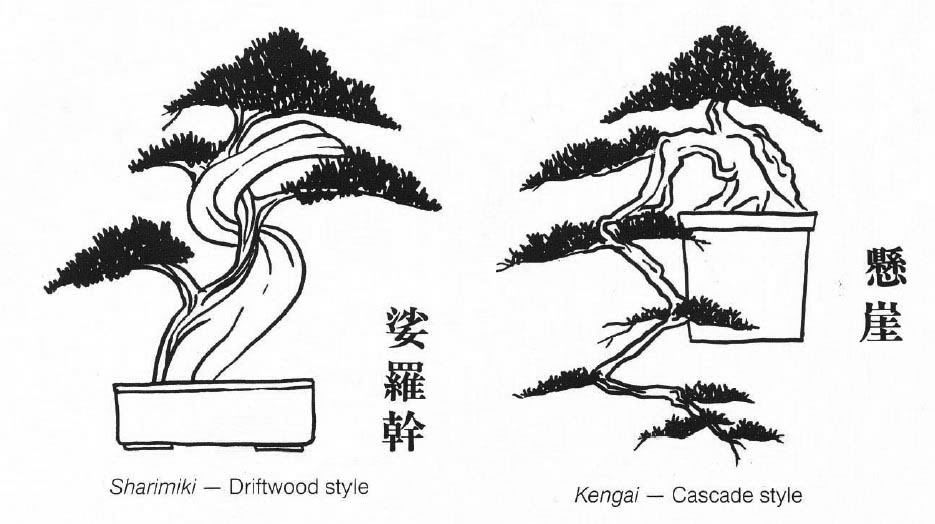
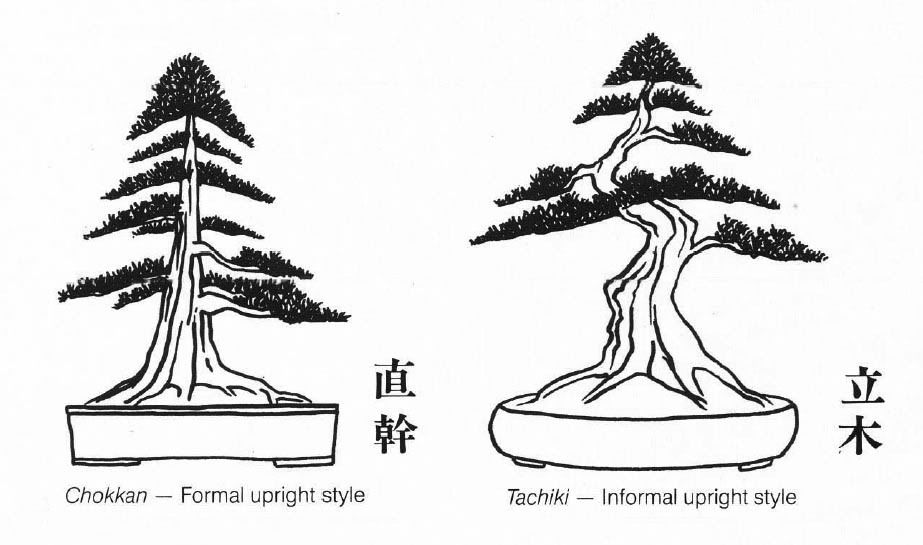
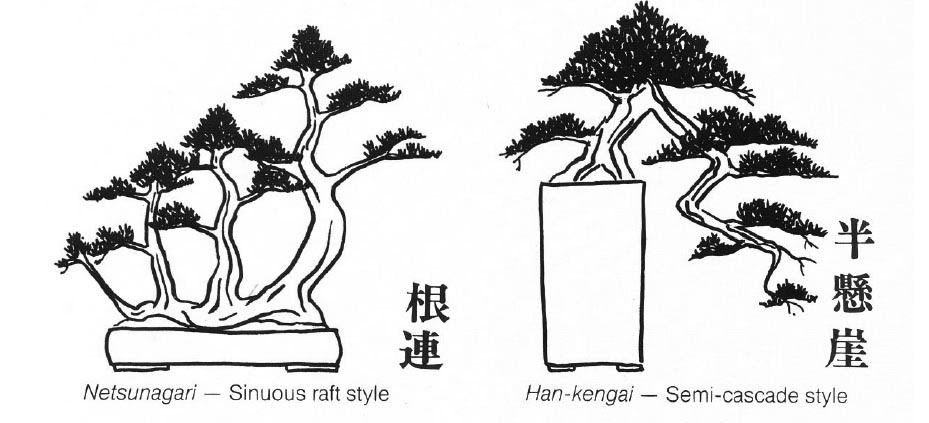
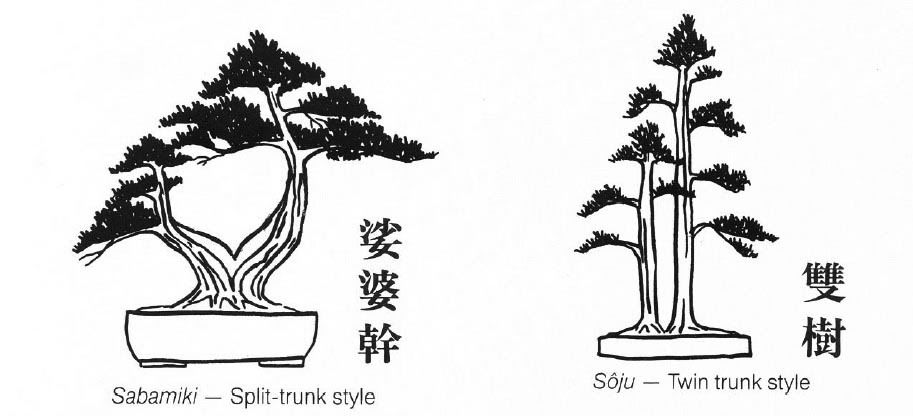

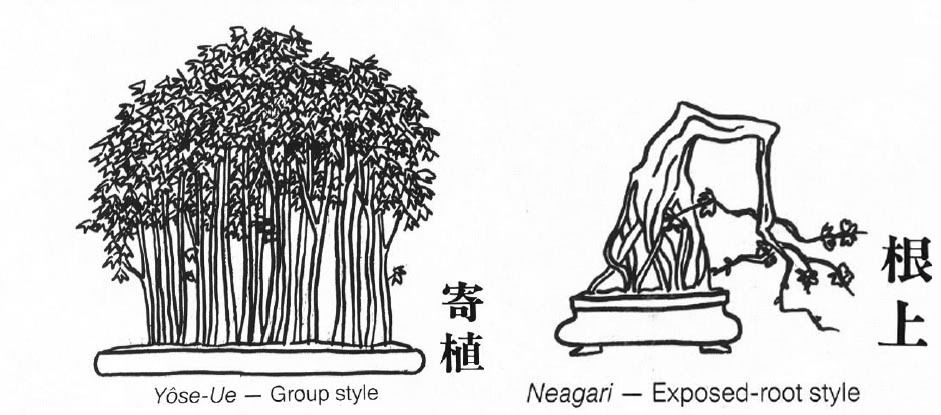
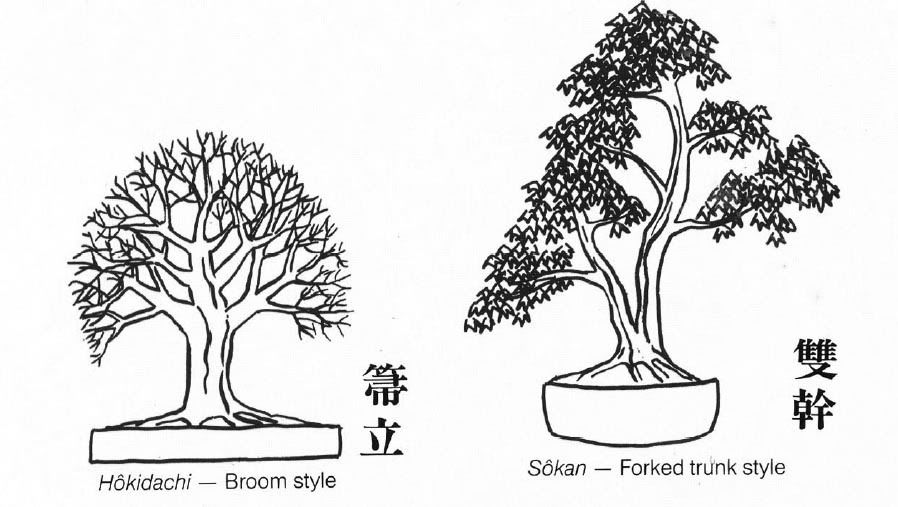
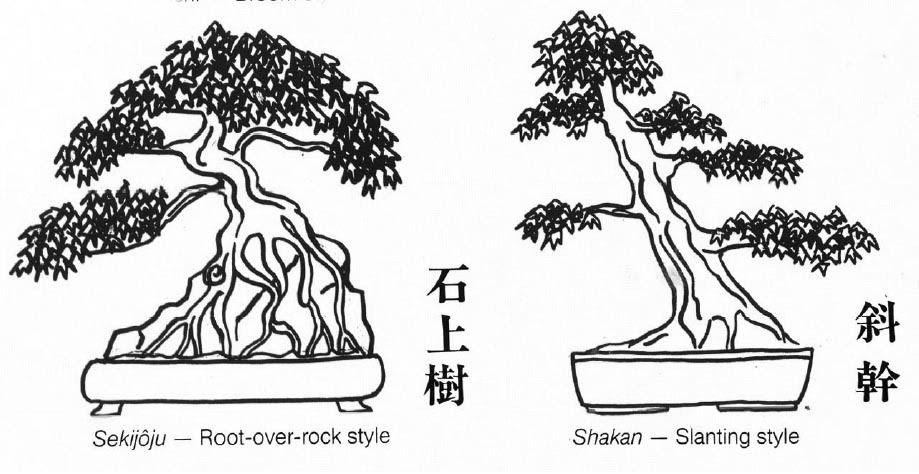
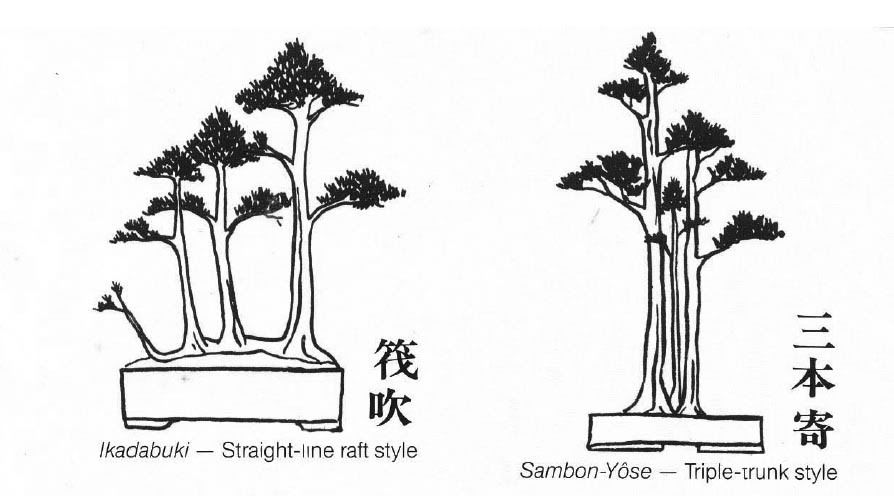
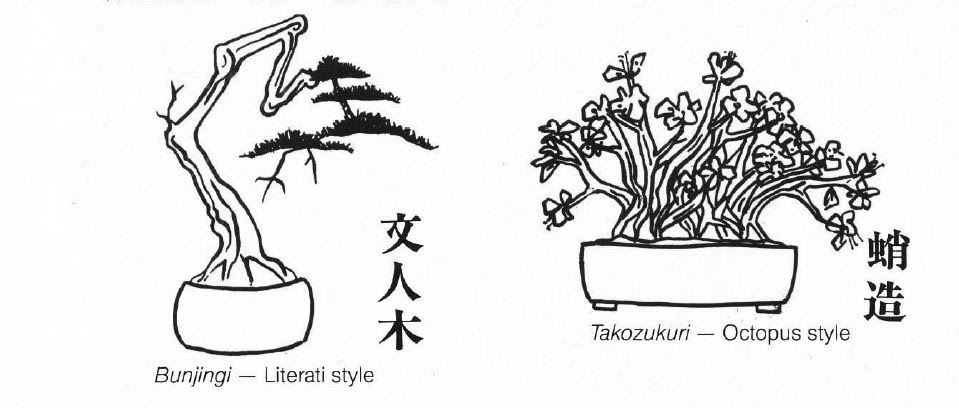
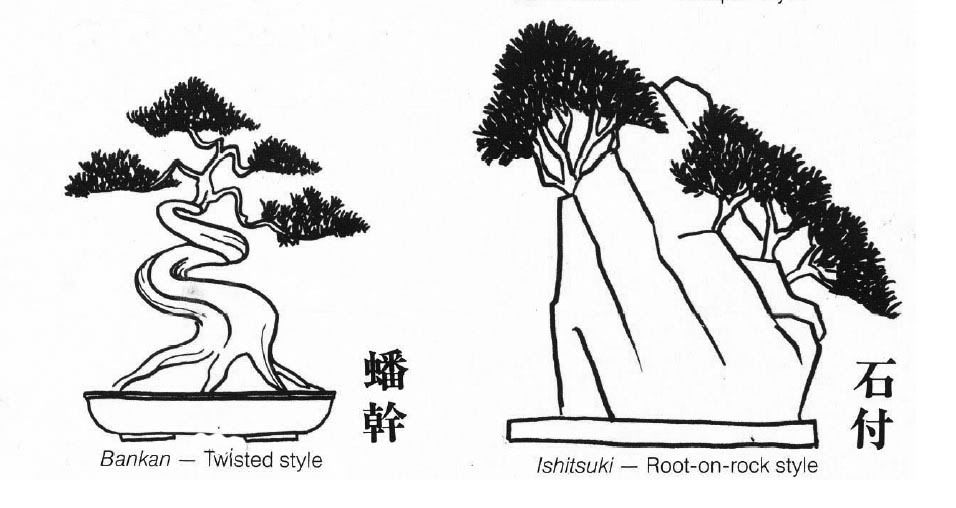
BEGINNING A BONSAI COLLECTION
Without doubt the easiest way to begin is by buying a bonsai. It should already be clear that buying a bonsai means buying the grower's time and effort, perhaps over many years; good bonsai are therefore expensive. There is great satis-faction in owning a fine specimen, perhaps to be used as a yardstick against which to judge one's own efforts in future. However a specimen tree requires attention throughout the year just like any other bonsai and the beginner may be wary, and rightly so, of learning the various techniques on his prize possession. If beginning a collection with an expensive purchase it is advisable to make friends rapidly with an experienced bonsai enthusiast or join a club or society to get advice, particularly during the first year.
Many excellent potential bonsai can be obtained from a garden centre or nursery. Young plants are relatively cheap, and interestin shapes which will make good bonsai are often shunned by the ordinary gardener. Sometimes the nurseryman may even be glad to have them taken off his hands at a reduced price. The poten-tial bonsai should of course be healthy and preferably have a good thick trunk. When grown in a container in a nursery the trunk is often hid-den below the soil level. A thick trunk and good top growth generally indicate good roots and this combination provides the soundest starting point for good bonsai. Container trees of course can be bought at any time of the year and keptuntil the appropriate time to begin training. Trees grown in the ground will have to be accepted fordelivery at the normal time and heeled into the garden to await the right time of year for potting. Many of the very best bonsai have been found in the wild, high up in the mountains, on cliffs or on the seashore. But these may only be collected with the consent of the landowner, which is often difficult to obtain. The shape of the trunk is of paramount importance because, being old wood, it cannot be greatly altered. The branches are often poor but this should not discourage the collector because new branches can be encouraged
to grow by pruning.
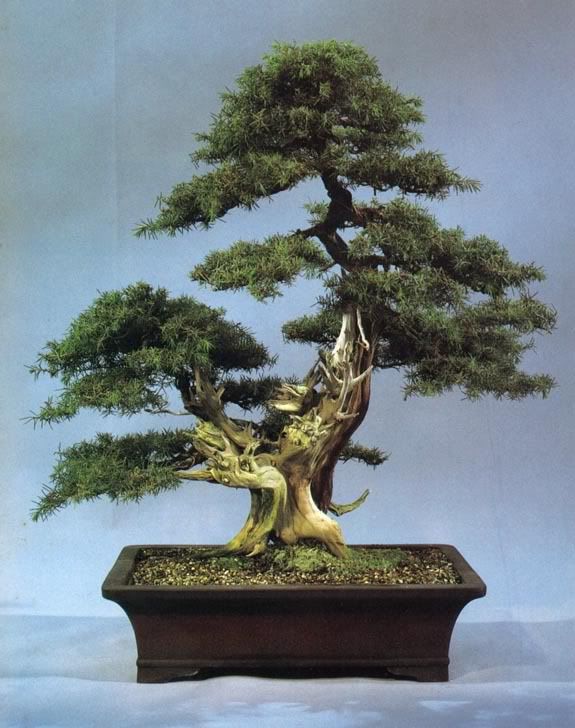
TWIN TRUNK, DRIFTWOODSTYLE NEEDLE JUNIPER(Juniperus rigida) hisT his most impressive tree, with its massesof dramatic driftwood, was reputed to be e ears old when it was imported in 1979. The form and mass of the lower trunk provide a perfect foil to the inch tallmain trunk.
The best season for collecting is in early spring before the new buds open. It is important to col-lect as much of the root of the tree as possible but in general terms the top of the tree should be pruned in proportion to the root ball. In early spring root growth is at its fastest. Nevertheless
it is usually advisable to plant a new acquisition in open ground for up to three years to regener-
ate new roots before it is potted. An alternative is to prune the roots in its natural home a year or more before final collection. Wild seedlings can also be collected and trained, being especially
suitable for group plantings. It goes without saying that the collector should abide by the law and seek the necessary permission for his activities. After being replanted, all trees collected in the wild should be protected from direct sun and wind, and the earth and surrounding atmosphere should be kept moist until the trees have overcome the shock of transplantation. If the tree is in good condition strong new buds will appear on the branches in duecourse.
Plants of any species may be grown from seed for training as bonsai, though of course this method is the slowest. For the best results fresh seed sown immediately after collection in the autumn is advised. Normal seed sowing proce-dures are used. Pine seedlings should be left undisturbed for a year but deciduous seedlings can be transplanted after about six months.
Seedlings will grow more quickly in the openground than in pots.Many trees, with the notable exception ofpines, can be propagated from cuttings. The cuttings are taken in the same way as for ordinary full-sized trees. It is generally accepted that there are two seasons for taking cuttings: early spring just as new buds are beginning to grow and late summer when the last growth is being made.
However experienced gardeners will know that these are rules that can frequently be broken. Sustained new growth will indicate a successful 'take'. At the end of six to 12 months, depending
upon the species, the cutting may be transplanted into a training pot or, as with seedlings, into the open ground if more rapid growth is required. Trees that allow you to take cuttings easily
often throw up plenty of suckers. Elm, birch and lilac all produce suckers and you can often get a good potential bonsai with roots already growing by taking a suitable sucker. However if you have to dig too deep for the roots the result is likely to be an unsatisfactory and leggy tree.
As a general rule first quality bonsai can never be created by grafting unless much effort over
many years is expended to erase the signs of the graft. As with all general rules there are exceptions but grafting is in any case a relatively complicated procedure, which is not recommended to the beginner in bonsai growing. Layering and dividing, which follow normal
garden practice, are also useful techniques for creating bonsai.

INFORMAL STYLE RED
HAWTHORN
(Crataegus cuneata)
Imported from Japan in 1975, this beautiful flowering hawthorn seems more ancient than its 50 years. The neat foliage,
delightful blossom, bright red fruit and well-formed branch structure make this truly a tree for all seasons. It is currently 20 inches tall.
SUITABLE BONSAI MATERIAL
The techniques of growing bonsai reduce the size of the leaves compared with those of a tree
grown in open ground. However, trees with naturally very large leaves do not as a rule reduce their leaf size sufficiently for the leaves to be in proportion to the size of the bonsai. Moreover
although leaf size is reduced by growing the tree as a bonsai, generally neither flower nor fruit
size is reduced.Thus certain plants are aesthetically unsuitable as bonsai unless the grower is
unconcerned by these disproportions. Few conifers present this problem but of the broad
leaved tree the field maple, for example, is more suitable than the sycamore and the white poplar than the black Italian poplar. However where the leaf is compound, as in mountain ash for example, the eye is deceived into regarding the small leaflets as leaves and for this reason many trees with compound leaves make very attractive bonsai. As was said earlier, bonsai is an art in which one seeks to create an impression. It follows that the most successful flowering and fruiting bonsai have naturally small flowers and fruits; cotoneaster, pyracantha and hawthorn are examples with these desirable features. Moreover all these have naturally small leaves.
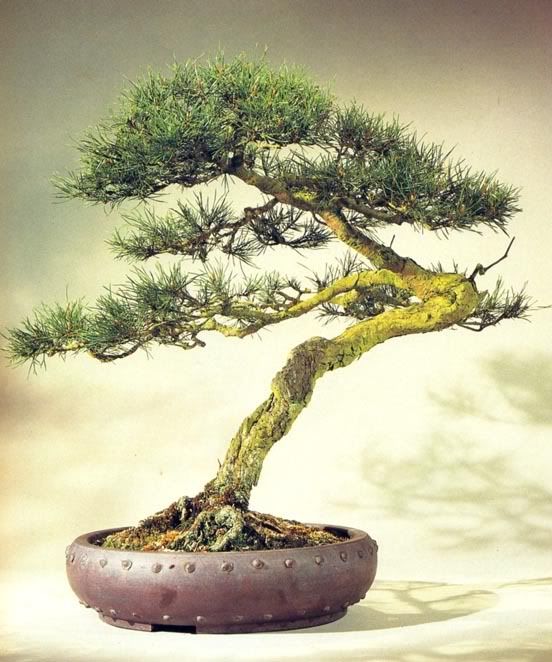
INFORMAL UPRIGHT SCOTS PINE
(Pinus sylvestris)
This highly individually styled yet
convincing tree was created by Peter
Adams from collected material. Its mature flakey bark and the severe bends in the trunk give this tree a natural craggy appearance which would be impossible to produce using nursery-grown stock. Its age is estimated to be around 60 years.
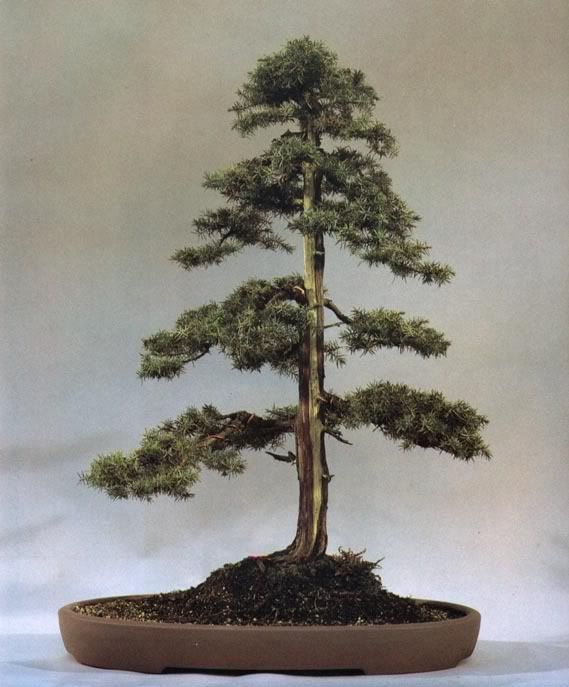
(Juniperus rigida)
The most striking feature of this 90 year old juniper isthe unusual 'shari' (exposed heartwood) which runs the entire length of the trunk. At 35 inches tall, this is a deceptively large tree.
Please look info to ......next CARE AND ATTENTION




No comments:
Post a Comment